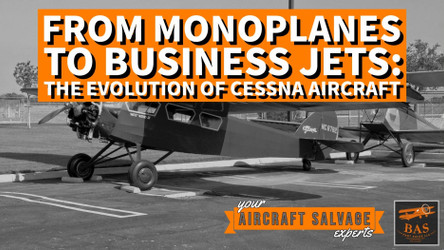From Monoplanes to Business Jets: The Evolution of Cessna Aircraft
Posted by Clinton McJenkin on Aug 22nd 2024
The history of Cessna Aircraft Company is a captivating journey that spans nearly a century, from its founding by Clyde Cessna in 1927 to its status as a leading manufacturer in general and business aviation today. Initially focusing on small, light aircraft, Cessna quickly gained recognition for its innovative designs, such as the Cessna 150 and the iconic Cessna 172, which became staples in pilot training and personal aviation. The company skillfully navigated the challenges of World War II, shifted its focus back to civilian aircraft post-war, and embraced technological advancements in the following decades, including the successful Citation series of business jets.


The Beginnings of Cessna
Cessna Aircraft Company was founded in 1927 by Clyde Cessna, a passionate aviator and a pioneer in the aviation industry. Initially, the company was established in the small town of Wichita, Kansas. Clyde Cessna was deeply involved in the early days of aviation, having built his first aircraft, the Cessna A, in 1911. He became known for his innovative designs and commitment to improving aircraft performance.
Expansion in the 1930s
The turning point for Cessna came during the 1930s when it began to produce a series of notable aircraft, including the Cessna 120 and 140 series, which became popular among pilots and flight instructors. These models were known for their reliability, ease of handling, and affordability, significantly contributing to the growth of general aviation.
In 1933, Cessna introduced the Cessna 150, a two-seat aircraft that became legendary in pilot training programs and personal aviation. Its robust design and excellent performance made it a favorite, setting the stage for the company's future successes.
The War Years
With the onset of World War II, Cessna, like many aviation manufacturers, shifted its focus to wartime production. The company produced military aircraft, including the Cessna O-1 Bird Dog, a reconnaissance aircraft used by the U.S. Army. This involvement in the war effort helped to establish Cessna's reputation for producing quality aircraft that met military requirements.
After the war, Cessna faced challenges as it transitioned back to civilian aircraft production. The demand for flying continued to grow, however, and the company quickly resumed its role in the general aviation market.
The Post-War Boom
The post-war era saw a surge in interest in private aviation, fueled by a growing economy and a newfound enthusiasm for flying. Cessna capitalized on this trend with the introduction of new models, such as the Cessna 172 in 1955, which would become one of the best-selling aircraft of all time. Known for its stability, simplicity, and versatility, the 172 has been a mainstay in flight schools and among private pilots worldwide.
During this period, Cessna also diversified its aircraft offerings, introducing the Cessna 180 and 185 series, which were designed for more rugged conditions and appealing to bush pilots and those needing aircraft for off-field operations.
Technological Advancements in the 1960s and 70s
As technology advanced in the aviation industry, Cessna continued to innovate. The introduction of the Cessna 206 and the Cessna 310 extended the company's reach into larger aircraft capable of carrying more passengers and cargo. The 1970s also saw the introduction of Cessna's Citation series jets, entering the business aviation market and solidifying their position as a versatile manufacturer catering to both private and commercial aviation needs.
The Citation I, launched in 1971, was a radical step into the world of business jets, offering speed and range that appealed to corporations and affluent individuals.
Challenges and Changes in the 1980s
The 1980s presented challenges for Cessna and the general aviation market due to economic downturns, with a significant decrease in the demand for new aircraft. Cessna was forced to scale back production, and in 1986, it was acquired by General Dynamics. The company concentrated its efforts on reviving its production lines and ensuring quality standards remained high during economically tough times.
In 1992, Cessna was sold to Textron Inc., and this new ownership facilitated further innovation and product development.
The New Millennium
Entering the 2000s, Cessna expanded its lineup with new models such as the Cessna 350 and Cessna 400, which continued to push the boundaries of technology and performance in general aviation. The company's focus on modernizing its aircraft with advanced avionics and efficient engines helped it maintain a competitive edge in an evolving marketplace.
The introduction of the Citation Mustang in 2006 also showcased Cessna's continued commitment to the business jet sector, catering to the emerging demand for light jets. Cessna has sustained strong growth through innovation and adaptation, positioning itself as a leading force in both general and business aviation.
Recent Developments
In recent years, Cessna has embraced new technology trends, including advanced materials and automation in production processes. Additionally, the company has focused on sustainability, exploring more environmentally friendly power sources and operational efficiencies.
As of 2024, Cessna remains a preeminent manufacturer of aircraft and is known globally for its contributions to aviation. The company has built a legacy that not only includes iconic aircraft but also a commitment to safety, performance, and reliability in flying.
10 Significant Cessna Facts:
2. Best-Selling Aircraft: The Cessna 172 Skyhawk is recognized as the best-selling aircraft of all time, with over 44,000 units produced since its introduction in 1956.
3. Market Share: Cessna has consistently held a significant market share in the general aviation sector, often ranking among the top manufacturers alongside competitors like Piper and Beechcraft.
4. Production Volume: At its peak in the late 1970s, Cessna was producing over 5,000 aircraft annually.
5. Citation Series: The Citation series, launched in 1971, has seen over 7,000 units delivered across various models, making it one of the most successful lines of business jets.
6. Global Presence: Cessna has delivered aircraft to over 170 countries worldwide, showcasing its significant global influence in aviation.
7. Service and Support: Cessna boasts a network of over 300 service centers globally, providing maintenance, repairs, and support for its aircraft.
8. Employee Base: Cessna employs thousands of individuals, with estimates around 5,000 employees working directly in Wichita and other facilities.
9. Safety Record: Cessna aircraft are renowned for their safety, with many models featuring design elements and technologies that enhance operational safety for pilots and passengers.
10. Training Impact: An estimated 70% of all pilots in the United States have trained in a Cessna aircraft, further solidifying its status as a cornerstone of pilot training programs.
Conclusion
Cessna's history reflects the evolution of aviation over nearly a century. From its humble beginnings in the late 1920s through the technological advancements of today, Cessna has consistently adapted to meet the needs of pilots, businesses, and the evolving landscape of aviation. Its lasting legacy is seen in the countless pilots who have learned to fly in a Cessna and the many travelers who have benefited from its aircraft for business and leisure.
The brand remains synonymous with general aviation, thanks to its groundbreaking developments and unwavering dedication to quality and innovation.








